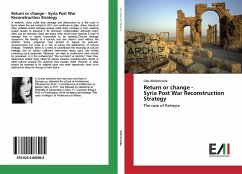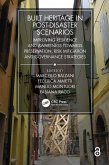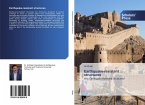Bernadette Devilat L.
Digital Records, Heritage Conservation and Post-earthquake Re-construction in Chile
Bernadette Devilat L.
Digital Records, Heritage Conservation and Post-earthquake Re-construction in Chile
- Gebundenes Buch
- Merkliste
- Auf die Merkliste
- Bewerten Bewerten
- Teilen
- Produkt teilen
- Produkterinnerung
- Produkterinnerung
This book challenges reconstruction as a replica to physically preserve damaged built heritage by critically examining a context of constant change resulting from earthquakes - Chile - advocating for the digital record to be an analytical basis for design, following the principles embedded in vernacular domestic architecture.
Andere Kunden interessierten sich auch für
![Seismic Design for Architects Seismic Design for Architects]() Andrew CharlesonSeismic Design for Architects178,99 €
Andrew CharlesonSeismic Design for Architects178,99 €![A Decision-Makers Guide to Public Private Partnerships in Airports A Decision-Makers Guide to Public Private Partnerships in Airports]() Andy RicoverA Decision-Makers Guide to Public Private Partnerships in Airports160,99 €
Andy RicoverA Decision-Makers Guide to Public Private Partnerships in Airports160,99 €![Return or change - Syria Post War Reconstruction Strategy Return or change - Syria Post War Reconstruction Strategy]() Lilas AbdulmawlaReturn or change - Syria Post War Reconstruction Strategy41,99 €
Lilas AbdulmawlaReturn or change - Syria Post War Reconstruction Strategy41,99 €![A History of the Earthquake and Fire in San Francisco A History of the Earthquake and Fire in San Francisco]() Frank W AitkenA History of the Earthquake and Fire in San Francisco32,99 €
Frank W AitkenA History of the Earthquake and Fire in San Francisco32,99 €![Designing Post-Virtual Architectures Designing Post-Virtual Architectures]() Heather BarkerDesigning Post-Virtual Architectures171,99 €
Heather BarkerDesigning Post-Virtual Architectures171,99 €![Built Heritage in post-Disaster Scenarios Built Heritage in post-Disaster Scenarios]() Built Heritage in post-Disaster Scenarios268,99 €
Built Heritage in post-Disaster Scenarios268,99 €![Earthquake-resistant structures Earthquake-resistant structures]() Ali KhakiEarthquake-resistant structures40,99 €
Ali KhakiEarthquake-resistant structures40,99 €-
-
-
This book challenges reconstruction as a replica to physically preserve damaged built heritage by critically examining a context of constant change resulting from earthquakes - Chile - advocating for the digital record to be an analytical basis for design, following the principles embedded in vernacular domestic architecture.
Produktdetails
- Produktdetails
- Verlag: Routledge
- Seitenzahl: 294
- Erscheinungstermin: 30. Mai 2025
- Englisch
- Abmessung: 240mm x 161mm x 20mm
- Gewicht: 608g
- ISBN-13: 9780367776237
- ISBN-10: 0367776235
- Artikelnr.: 72006275
- Herstellerkennzeichnung
- Libri GmbH
- Europaallee 1
- 36244 Bad Hersfeld
- gpsr@libri.de
- Verlag: Routledge
- Seitenzahl: 294
- Erscheinungstermin: 30. Mai 2025
- Englisch
- Abmessung: 240mm x 161mm x 20mm
- Gewicht: 608g
- ISBN-13: 9780367776237
- ISBN-10: 0367776235
- Artikelnr.: 72006275
- Herstellerkennzeichnung
- Libri GmbH
- Europaallee 1
- 36244 Bad Hersfeld
- gpsr@libri.de
Bernadette Devilat L., also known as Bernardita, is an assistant professor at the Department of Architecture and Built Environment of the University of Nottingham, part of the Architecture, Culture and Tectonics Research Group, where she teaches and leads research projects as Principal Investigator. She graduated as an Architect in Chile with a Master's in Architecture at the Pontificia Universidad Católica, followed by a PhD in Architectural Design from the Bartlett School of Architecture, University College London. Her research includes critical and novel uses of accurate recording technologies - mainly 3D-laser-scanning - to conserve built heritage at risk with case studies in Chile and India. She co-founded the Tarapacá Project, created after the 2005 earthquake in Chile; and DLA Scan Architectural Studio with built projects in Chile. She has research and teaching experience at all the universities listed, and Nottingham Trent University. She has published, given guest keynotes and lectures, exhibited and presented her work internationally, and received prestigious awards.
List of figures
List of abbreviations
Acknowledgements
Preface
Introduction
Situating the argument
Earthquakes in Chile
Re-construction and record
Structure of the book
Chapter 1: Built heritage conservation
1.1. A brief history of conservation
1.1.1. Initial attempts
1.1.2. Rome and beyond
1.1.3. Middle Ages
1.1.4. From the Renaissance
1.1.5. The becoming of heritage
1.2 Why conserve?
1.2.1. Living heritage: tangible and intangible
1.2.2. Sustainability and economic value
1.2.3. Tourism
1.2.4. Memory and the construction of history
1.3 How to conserve?
1.3.1. Concepts of intervention in built heritage
1.3.2. Reconstruction and re-construction
1.3.3. Time in built heritage restoration
1.3.4. Continuous conservation
1.3.5. Two intervention extremes
1.4. Concluding remarks
Chapter 2: Recording heritage buildings
2.1. Architectural representation, building and measuring
2.1.1 Building as recording
2.1.2. Architectural treatises
2.1.3. Other records
2.2. Surveying buildings
2.2.1. Hand-measuring method
2.2.2. Photography
2.2.3. 3D imaging
2.2.4. 3D scanning using projected light
2.2.5. 3D-laser-scanning
2.3. The rise of digital recording technologies
2.3.1. Products from the 3D record
2.3.2. Designing from the 3D scan data
2.3.3. The paradox of the complete record
2.3.4. Record and archive
2.3.5. Continuous modelling and design
2.3.6. Visual replica
2.4. Concluding remarks
Chapter 3: Record and reconstruction in the face of destruction
3.1. Potential destruction
3.1.1. The record
3.1.2. Rebuilding as replica
3.1.3. The paradox of the original
3.2 Recording for re-construction
3.2.1 Documenting to manage risk
3.2.2 Post-destruction assessment and documen
3.3 Post-earthquake intervention of heritage areas
3.3.1 Building techniques in reconstruction and re-construction
3.4. Concluding remarks
Chapter 4: Reconstruction of heritage areas in Chile
4.1. Built heritage in Chile
4.1.1. Continuous destruction because of earthquakes
4.1.2 Heritage stance
4.1.3. Recording heritage buildings
4.1.4 Mitigation of heritage damage
4.2. Case studies
4.2.1. Two earthquakes
4.2.2 Chilean heritage areas
4.2.3. Tarapacá
4.2.4. Zúñiga
4.2.5. Lolol
4.3. Reconstruction after earthquakes in Chile
4.3.1. Emergency period
4.3.2. Permanent housing
4.3.3. Post-earthquake surveys
4.3.4. 2005 Earthquake
4.3.5. 2010 Earthquake
4.4. Persisting challenges
4.4.1. Emergency period
4.4.2 Reconstruction process
4.5. Concluding remarks
Chapter 5: The record
5.1. Data capture on-site
5.1.1. Documenting the built environment
5.1.2. Inhabitants' perception
5.2. Visualisation
5.3 Limitations
5.4 The record for analysis
5.4.1. Post-earthquake surveys
5.4.2 Architectural design, heritage elements and the sustainability of the
new "heritage" dwellings
5.4.3. The paradox of authentic reproduction
5.5. Concluding remarks
Chapter 6: Re-construction alternative
6.1. Documenting to mitigate risk
6.1.1. Mitigation retrofitting
6.1.2. Integrating inhabitants
6.2. Designing from the record
6.2.1. Time
6.2.2 Spatial use: the inhabited record
6.2.3 Sustainability and materiality
6.3.2. Spatial use: the inhabited record
6.3 Re-construction
6.3.1 Tarapacá - memory
6.3.2 Zúñiga - use
6.3.3. Lolol - in-between
6.4. Concluding remarks
Conclusions
Methodology
As a post-earthquake documenting tool
As a basis for analysis and design
Going beyond the buildings
Implications
New Buildings for old
Mitigation as conservation
Continuous transformation
Projections
References
Index
List of abbreviations
Acknowledgements
Preface
Introduction
Situating the argument
Earthquakes in Chile
Re-construction and record
Structure of the book
Chapter 1: Built heritage conservation
1.1. A brief history of conservation
1.1.1. Initial attempts
1.1.2. Rome and beyond
1.1.3. Middle Ages
1.1.4. From the Renaissance
1.1.5. The becoming of heritage
1.2 Why conserve?
1.2.1. Living heritage: tangible and intangible
1.2.2. Sustainability and economic value
1.2.3. Tourism
1.2.4. Memory and the construction of history
1.3 How to conserve?
1.3.1. Concepts of intervention in built heritage
1.3.2. Reconstruction and re-construction
1.3.3. Time in built heritage restoration
1.3.4. Continuous conservation
1.3.5. Two intervention extremes
1.4. Concluding remarks
Chapter 2: Recording heritage buildings
2.1. Architectural representation, building and measuring
2.1.1 Building as recording
2.1.2. Architectural treatises
2.1.3. Other records
2.2. Surveying buildings
2.2.1. Hand-measuring method
2.2.2. Photography
2.2.3. 3D imaging
2.2.4. 3D scanning using projected light
2.2.5. 3D-laser-scanning
2.3. The rise of digital recording technologies
2.3.1. Products from the 3D record
2.3.2. Designing from the 3D scan data
2.3.3. The paradox of the complete record
2.3.4. Record and archive
2.3.5. Continuous modelling and design
2.3.6. Visual replica
2.4. Concluding remarks
Chapter 3: Record and reconstruction in the face of destruction
3.1. Potential destruction
3.1.1. The record
3.1.2. Rebuilding as replica
3.1.3. The paradox of the original
3.2 Recording for re-construction
3.2.1 Documenting to manage risk
3.2.2 Post-destruction assessment and documen
3.3 Post-earthquake intervention of heritage areas
3.3.1 Building techniques in reconstruction and re-construction
3.4. Concluding remarks
Chapter 4: Reconstruction of heritage areas in Chile
4.1. Built heritage in Chile
4.1.1. Continuous destruction because of earthquakes
4.1.2 Heritage stance
4.1.3. Recording heritage buildings
4.1.4 Mitigation of heritage damage
4.2. Case studies
4.2.1. Two earthquakes
4.2.2 Chilean heritage areas
4.2.3. Tarapacá
4.2.4. Zúñiga
4.2.5. Lolol
4.3. Reconstruction after earthquakes in Chile
4.3.1. Emergency period
4.3.2. Permanent housing
4.3.3. Post-earthquake surveys
4.3.4. 2005 Earthquake
4.3.5. 2010 Earthquake
4.4. Persisting challenges
4.4.1. Emergency period
4.4.2 Reconstruction process
4.5. Concluding remarks
Chapter 5: The record
5.1. Data capture on-site
5.1.1. Documenting the built environment
5.1.2. Inhabitants' perception
5.2. Visualisation
5.3 Limitations
5.4 The record for analysis
5.4.1. Post-earthquake surveys
5.4.2 Architectural design, heritage elements and the sustainability of the
new "heritage" dwellings
5.4.3. The paradox of authentic reproduction
5.5. Concluding remarks
Chapter 6: Re-construction alternative
6.1. Documenting to mitigate risk
6.1.1. Mitigation retrofitting
6.1.2. Integrating inhabitants
6.2. Designing from the record
6.2.1. Time
6.2.2 Spatial use: the inhabited record
6.2.3 Sustainability and materiality
6.3.2. Spatial use: the inhabited record
6.3 Re-construction
6.3.1 Tarapacá - memory
6.3.2 Zúñiga - use
6.3.3. Lolol - in-between
6.4. Concluding remarks
Conclusions
Methodology
As a post-earthquake documenting tool
As a basis for analysis and design
Going beyond the buildings
Implications
New Buildings for old
Mitigation as conservation
Continuous transformation
Projections
References
Index
List of figures
List of abbreviations
Acknowledgements
Preface
Introduction
Situating the argument
Earthquakes in Chile
Re-construction and record
Structure of the book
Chapter 1: Built heritage conservation
1.1. A brief history of conservation
1.1.1. Initial attempts
1.1.2. Rome and beyond
1.1.3. Middle Ages
1.1.4. From the Renaissance
1.1.5. The becoming of heritage
1.2 Why conserve?
1.2.1. Living heritage: tangible and intangible
1.2.2. Sustainability and economic value
1.2.3. Tourism
1.2.4. Memory and the construction of history
1.3 How to conserve?
1.3.1. Concepts of intervention in built heritage
1.3.2. Reconstruction and re-construction
1.3.3. Time in built heritage restoration
1.3.4. Continuous conservation
1.3.5. Two intervention extremes
1.4. Concluding remarks
Chapter 2: Recording heritage buildings
2.1. Architectural representation, building and measuring
2.1.1 Building as recording
2.1.2. Architectural treatises
2.1.3. Other records
2.2. Surveying buildings
2.2.1. Hand-measuring method
2.2.2. Photography
2.2.3. 3D imaging
2.2.4. 3D scanning using projected light
2.2.5. 3D-laser-scanning
2.3. The rise of digital recording technologies
2.3.1. Products from the 3D record
2.3.2. Designing from the 3D scan data
2.3.3. The paradox of the complete record
2.3.4. Record and archive
2.3.5. Continuous modelling and design
2.3.6. Visual replica
2.4. Concluding remarks
Chapter 3: Record and reconstruction in the face of destruction
3.1. Potential destruction
3.1.1. The record
3.1.2. Rebuilding as replica
3.1.3. The paradox of the original
3.2 Recording for re-construction
3.2.1 Documenting to manage risk
3.2.2 Post-destruction assessment and documen
3.3 Post-earthquake intervention of heritage areas
3.3.1 Building techniques in reconstruction and re-construction
3.4. Concluding remarks
Chapter 4: Reconstruction of heritage areas in Chile
4.1. Built heritage in Chile
4.1.1. Continuous destruction because of earthquakes
4.1.2 Heritage stance
4.1.3. Recording heritage buildings
4.1.4 Mitigation of heritage damage
4.2. Case studies
4.2.1. Two earthquakes
4.2.2 Chilean heritage areas
4.2.3. Tarapacá
4.2.4. Zúñiga
4.2.5. Lolol
4.3. Reconstruction after earthquakes in Chile
4.3.1. Emergency period
4.3.2. Permanent housing
4.3.3. Post-earthquake surveys
4.3.4. 2005 Earthquake
4.3.5. 2010 Earthquake
4.4. Persisting challenges
4.4.1. Emergency period
4.4.2 Reconstruction process
4.5. Concluding remarks
Chapter 5: The record
5.1. Data capture on-site
5.1.1. Documenting the built environment
5.1.2. Inhabitants' perception
5.2. Visualisation
5.3 Limitations
5.4 The record for analysis
5.4.1. Post-earthquake surveys
5.4.2 Architectural design, heritage elements and the sustainability of the
new "heritage" dwellings
5.4.3. The paradox of authentic reproduction
5.5. Concluding remarks
Chapter 6: Re-construction alternative
6.1. Documenting to mitigate risk
6.1.1. Mitigation retrofitting
6.1.2. Integrating inhabitants
6.2. Designing from the record
6.2.1. Time
6.2.2 Spatial use: the inhabited record
6.2.3 Sustainability and materiality
6.3.2. Spatial use: the inhabited record
6.3 Re-construction
6.3.1 Tarapacá - memory
6.3.2 Zúñiga - use
6.3.3. Lolol - in-between
6.4. Concluding remarks
Conclusions
Methodology
As a post-earthquake documenting tool
As a basis for analysis and design
Going beyond the buildings
Implications
New Buildings for old
Mitigation as conservation
Continuous transformation
Projections
References
Index
List of abbreviations
Acknowledgements
Preface
Introduction
Situating the argument
Earthquakes in Chile
Re-construction and record
Structure of the book
Chapter 1: Built heritage conservation
1.1. A brief history of conservation
1.1.1. Initial attempts
1.1.2. Rome and beyond
1.1.3. Middle Ages
1.1.4. From the Renaissance
1.1.5. The becoming of heritage
1.2 Why conserve?
1.2.1. Living heritage: tangible and intangible
1.2.2. Sustainability and economic value
1.2.3. Tourism
1.2.4. Memory and the construction of history
1.3 How to conserve?
1.3.1. Concepts of intervention in built heritage
1.3.2. Reconstruction and re-construction
1.3.3. Time in built heritage restoration
1.3.4. Continuous conservation
1.3.5. Two intervention extremes
1.4. Concluding remarks
Chapter 2: Recording heritage buildings
2.1. Architectural representation, building and measuring
2.1.1 Building as recording
2.1.2. Architectural treatises
2.1.3. Other records
2.2. Surveying buildings
2.2.1. Hand-measuring method
2.2.2. Photography
2.2.3. 3D imaging
2.2.4. 3D scanning using projected light
2.2.5. 3D-laser-scanning
2.3. The rise of digital recording technologies
2.3.1. Products from the 3D record
2.3.2. Designing from the 3D scan data
2.3.3. The paradox of the complete record
2.3.4. Record and archive
2.3.5. Continuous modelling and design
2.3.6. Visual replica
2.4. Concluding remarks
Chapter 3: Record and reconstruction in the face of destruction
3.1. Potential destruction
3.1.1. The record
3.1.2. Rebuilding as replica
3.1.3. The paradox of the original
3.2 Recording for re-construction
3.2.1 Documenting to manage risk
3.2.2 Post-destruction assessment and documen
3.3 Post-earthquake intervention of heritage areas
3.3.1 Building techniques in reconstruction and re-construction
3.4. Concluding remarks
Chapter 4: Reconstruction of heritage areas in Chile
4.1. Built heritage in Chile
4.1.1. Continuous destruction because of earthquakes
4.1.2 Heritage stance
4.1.3. Recording heritage buildings
4.1.4 Mitigation of heritage damage
4.2. Case studies
4.2.1. Two earthquakes
4.2.2 Chilean heritage areas
4.2.3. Tarapacá
4.2.4. Zúñiga
4.2.5. Lolol
4.3. Reconstruction after earthquakes in Chile
4.3.1. Emergency period
4.3.2. Permanent housing
4.3.3. Post-earthquake surveys
4.3.4. 2005 Earthquake
4.3.5. 2010 Earthquake
4.4. Persisting challenges
4.4.1. Emergency period
4.4.2 Reconstruction process
4.5. Concluding remarks
Chapter 5: The record
5.1. Data capture on-site
5.1.1. Documenting the built environment
5.1.2. Inhabitants' perception
5.2. Visualisation
5.3 Limitations
5.4 The record for analysis
5.4.1. Post-earthquake surveys
5.4.2 Architectural design, heritage elements and the sustainability of the
new "heritage" dwellings
5.4.3. The paradox of authentic reproduction
5.5. Concluding remarks
Chapter 6: Re-construction alternative
6.1. Documenting to mitigate risk
6.1.1. Mitigation retrofitting
6.1.2. Integrating inhabitants
6.2. Designing from the record
6.2.1. Time
6.2.2 Spatial use: the inhabited record
6.2.3 Sustainability and materiality
6.3.2. Spatial use: the inhabited record
6.3 Re-construction
6.3.1 Tarapacá - memory
6.3.2 Zúñiga - use
6.3.3. Lolol - in-between
6.4. Concluding remarks
Conclusions
Methodology
As a post-earthquake documenting tool
As a basis for analysis and design
Going beyond the buildings
Implications
New Buildings for old
Mitigation as conservation
Continuous transformation
Projections
References
Index








